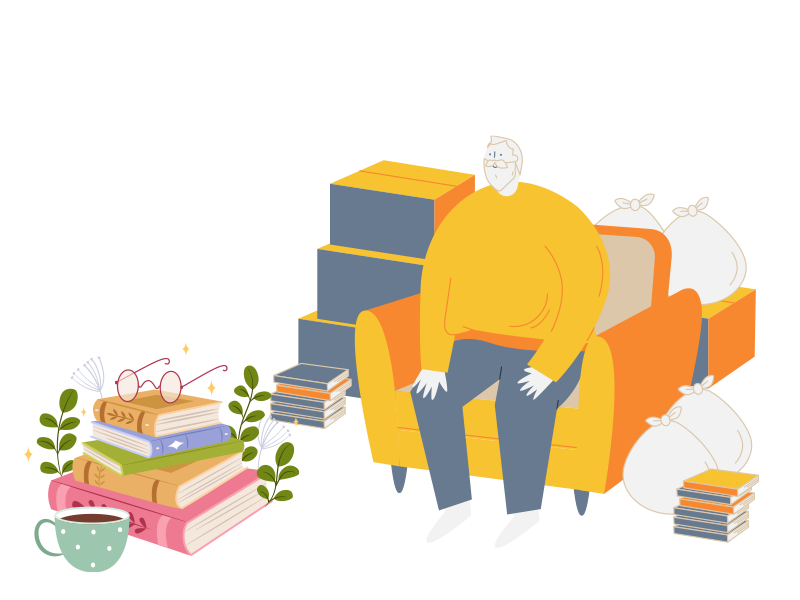What Is Hoarding Disorder?
Have you ever wondered why some people collect all kinds of worthless junk? Junk is defined as goods with no real value, even sentimental value. So, someone who has what doctors call “hoarding disorder” doesn’t collect things like stamps, coins, jewelry, or other items that have value.
Anyone who suffers from the disorder tends to amass all sorts of things with zero value. Why do they do it? Doctors say it’s because they suffer from a genuine psychological condition that causes them to hoard. There’s no logic behind the behavior, and about four percent of the population suffers from it.
Of course, some cases are more troublesome than others, so perhaps only a fraction of that four percent need professional help.
Getting a Handle on Hoarding
If you’ve never heard of hoarding disorder, it’s important to learn the basics about its common causes, typical symptoms, methods of diagnosis, tests for it, methods for managing it, possible ways to treat it, and more. Here’s the least you should know about this serious mental condition.
What Does the Disorder Look Like?
No two cases of this disorder are exactly alike, but all people who have it tend to have a powerful urge to keep all kinds of objects. That’s the overriding symptom. However, like so many other psychological and physical ailments, there are long lists of related symptoms.
For hoarders, a few common ones include:
- Not ever knowing where things should be appropriately stored
- The partial or complete inability to get rid of various hoarded goods
- Residing in a living space that is no longer functional due to all the clutter
- High levels of mental stress and anguish at the thought of throwing things away
- Trying to stay away from family, neighbors, and acquaintances
- Worrying that other people might try to steal or touch any of their hoarded items
What are the Main Risk Factors?
Because no one is sure what causes the hoarding disorder, professionals speak more about risk factors than direct causes. That means you should be on the lookout for behaviors that could be a strong signal that you or someone you know hoards things excessively. Here are some of the main signals:
- Having endured a traumatic situation or mentally debilitating life event
- Having a family member who shows signs of being a hoarder
- Always accepting free things when they’re offered, especially certificates and coupons
- A head injury that possibly leads directly to the behavior of hoarding
- The inability to stop buying unneeded consumer goods
- OCD, obsessive-compulsive disorder or various levels of depression
Diagnosing the Disorder
It’s rare for someone who suffers from the disorder to seek help. In nearly every case, loved ones contact mental health workers for assistance. If you or someone you know is a candidate for treatment, speak directly with a mental health provider. Look for the telltale sign: unsafe or unsanitary living spaces.
The good news is that trained professionals look at the situation and determine whether the person has an actual case of the disorder. The next step is to get treatment in order to begin the healing process.
Generally, doctors look for three signs that point to the problem. Only then can a person be definitively diagnosed. The three signs are:
1. At least part of the sufferer’s home is not fully functional or usable due to being filled up with unnecessary items
2. The person has anxiety or extreme stress at the mere thought of having to get rid of some or all of the hoarded items
3. A recurring problem getting rid of any kind of belongings
Treatment and Prevention

Like so many other mental conditions, hoarding-related disorder has unknown causes. That makes it practically impossible to be prevented. However, there is good news. There are two very effective ways to treat the condition. The first is therapy-based, and the second is drug-based.
CBT: Medical professionals use talk therapy called CBT, cognitive-behavioral therapy, to help hoarders get back to living normal, happy lives. Therapists who use CBT help sufferers learn why they want to keep so many unneeded things. That’s the first step to decreasing the general anxiety level that comes with tossing junk into the trash.
Further, people with the disorder can learn practical skills like how to arrange their living space so that’s it not unsanitary or full of clutter. Counselors also teach people how to decide what to throw away and what to keep.
Besides talk therapy, some professionals prescribe antidepressants, many of which can immediately help alleviate the symptoms hoarders can feel when they throw things away. And sometimes, doctors use both approaches to deal with excessive hoarding. The main thing to remember is that there are several effective treatment methods and strategies for the disorder and that the vast majority of people who seek help get better in a relatively short period of time.
One part of the treatment process is hiring cleaning services to do a full-scale junk removal of the property. Only then can the sufferer return to a life of normalcy.
How to Get Help
How should you get help if you know someone who suffers from this unique form of mental disorder? First, try to see if someone in your life hoards things of little value and apparently for no logical reason.
For example, some hoarders have massive collections of old newspapers, books, broken appliances, bottles, boxes, broken auto parts, and cartons full of papers and accumulated junk from years past. Sometimes hoarders keep excessive numbers of pets, which can be dangerous for the animals as well as the person keeping them.

In most cases, hoarding leads to unsanitary living conditions. That means one of the best things you can do if you know someone with the condition is contact a professional counselor. After that, help them remove their junk and clean up their living space. Some hoarders have been residing in unsanitary places for years and are at risk for skin infections, respiratory ailments, and worse.
In addition to counseling, it’s essential to bring in professional cleaning services to remove the junk safely and to sanitize the area asap, so that’s the owner can continue to live there. Junk removal is a major part of the healing process for the sufferer. It’s important for them to realize that living in a clean, uncluttered environment is safer and more rewarding than being around tons of dusty, unsanitary junk.
Cleaning hoarder house spaces is a big job and requires professional equipment, trained teams, and the right kind of substances to disinfect the area. Professional junk removal includes a menu of related services like removing and disposing of all the unwanted items, cleaning the space and disinfecting it, making sure that any remaining items are clean and free of hazardous materials, and using trained cleaners and appropriate equipment.
Hoarding disorder can be a life-threatening condition if left untreated. Cleaning hoarder house properties is an integral part of a comprehensive treatment plan that enables the sufferer to get on with their lives in a happy, healthy way.

About Jennifer Hanzlick
Clutter Trucker is a Denver-based hoarding clean-out company founded by Jennifer Hanzlick. Jennifer leveraged 15 years of corporate experience in to start the company in 2008. Her mission is to help and educate individuals and their loved ones who have hoarding disorder. A featured speaker at Ted X Boulder, Jennifer works directly with community and non-profit organizations to boost public awareness about the condition. To that end, she founded the Colorado Hoarding Task Force in 2015.
 720-982-7856
720-982-7856



